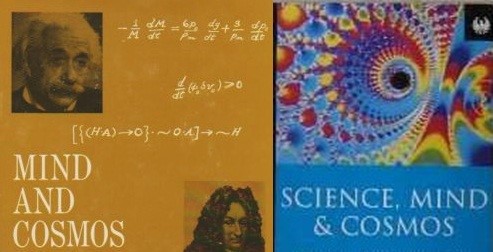There is no shortage of scientifically inspired theories of mind these days, and they seem to become more and more exotic in proportion to the scientific community’s frustration with its inability to find a logically coherent or empirically verifiable one: from mind as a physical product or epiphenomenal state of the brain, to cognitive function as an analog to A.I., to consciousness as an amalgamation of “integrated information” at the quantum level, to subjective mental experience as a product of state vector collapse in quantum dynamics, to mental life located in extra-spacetime dimensions of string-theory. The common shortcoming confounding all of these however, involves the classic “hard problem”: how the physical world as described by science can ever be, or cause, something as apparently non-physical as the conscious experience that comprises what we call mind. When we look at reality exclusively through the lens of science, we seem to inhabit a world made up entirely of physical entities, substances, and forces, none of which have (or CAN have, in any way that science is capable of making intelligible) the subjective awareness, self-directedness, or rational-emotional thoughts and feelings that we know of as ‘mind’ or consciousness. Conscious awareness is an extra-physical, immaterial and purely experiential dimension of existence, but it remains, as Descartes noted, the one undeniable, immediately and immanently real aspect of reality nonetheless. It is the only thing we experience in a ‘first-hand’, self-evident way, unmediated by any other concepts, perceptions or thoughts. Science yields a universe (or perhaps infinite universes) unable to accommodate or countenance anything beyond the physical parameters within which science is ineluctably bound. Conscious experience is irreducible to physical concepts, although necessary for such concepts to exist.
How do we get from one to the other when they seem so obviously different? Consciousness can’t, apparently, be something physical. Physical objects can’t magically produce consciousness. So how is it that our physical bodies and brains are animated by consciousness? What is the physical world, and what is mind, in light of this quandary?
One way (the way that has traditionally been adopted by the physical sciences) to approach these questions is to simply identify the mental with the physical by subsuming “mind” into “matter”. “Identity theories’, for instance, claim that what we call mind is just some form of physical matter –neurological or biochemical—that somehow has the additional properties that we associate with consciousness. This notion has often been tacitly assumed, but has always lacked both logical coherence (how, after all, can thoughts, feelings and awareness be physical things?—what measurable physical properties does consciousness have, and what discernable physical elements comprise it?) or any empirical evidence other than numerous correlations between brain activity and mental states (what demonstrable evidence there that some physical mechanism in the brain or elsewhere is actually conscious?—how could chemicals and neurons even be conscious?). Other “epiphenomenal” theories claim that brain-matter may not be conscious itself, but somehow produces consciousness. However, these theories face the same kind of problems (how logically or empirically does it make sense that something as non-physical as consciousness somehow emerges from the physical world?). Although currently fashionable, comparing the mind to a computer sometimes works well as a metaphor, but to say that the mind is just a complex computer seems untenable as well, since, as Roger Penrose deduced from Godel’s Incompleteness Theorem, minds do much more than just run complex algorithms. After all, super-computers can run algorithms on a much higher level of complexity than any human mind, but certainly don’t seem to have minds in the way that human beings do….
Beyond the more simplistic notions that physical brain and consciousness are -somehow- exactly the same thing, or are epiphenomenal emanations from physical substrates, other “emergence theories” (the idea that consciousness is something distinct from, but arises out of, its physical brain-matter substrate) are also gaining popularity. There is Tononi’s “integrated information’ theory (that consciousness is built up from bits of information at the quantum-Planck scale – the most basic scale of the universe- to levels of complexity that result in various levels of mental sophistication). Or the “orchestrated reduction” theory of Hameroff and Penrose (postulating that consciousness emerges at the quantum level during state vector collapse of the Schrodinger wave-function, which occurs in microtubules of the brain). The latter is, at least in principle, empirically testable and has resulted in some productive research. However, the scientific community’s current consensus is that these theories lack the kind of empirical evidence that convincing physical explanations require.
Other quasi-physical, vaguely ‘panpsychist’ explanations via quantum physics, like Wheeler’s ‘participatory universe’, have tried to turn the ‘hard problem’ on its head: viewing the physical world as, in some sense, imbued with consciousness as an observation-dependent animating property or force. Some prominent ‘conventional’ realist interpretations of quantum physics (explaining what it actually reveals about the real world) is that everything at the subatomic level exists in a “superposition” (literally in every possible place at once) via what is calculated as the Schrodinger wave function until someone ‘observes’ or ‘looks at’ it by taking some sort of measurement (or possibly when it interacts with some other entity — at which time this wave function of possible positions then “collapses” into a single place— where we observe a particular subatomic particle in a particular location. Some further interpretations of this process claim that perhaps HOW we choose to observe things determines what kind of physical state they ‘collapse’ into… that how we look at reality determines what reality becomes. What an “observation” at the quantum level might be is a matter of wide speculation, but they suggest that either a conscious observer (or mind) is necessary for this to occur, or that the wavefunction collapse creates matter and mind simultaneously. New theories and experiments seem to suggest that (possibly) this is also the case with macroscopic objects like trees and buildings and people. …. That we literally exist in a superposition of every possible physical state until we are observed, observe ourselves, or interact (in a way that constitutes an observation) with some other entity. ….and how we look at our daily reality determines (in some sense that we don’t yet understand) what reality becomes ….However even beyond their lack of empirical rigor, these ideas have been criticized for their lack of internal coherence as well. The very idea of ‘observation’ and ‘observers’ for instance, is, at present, so ill-defined and subjective that it has been impossible to reach any consensus about.
Current research and speculation surrounding “simulation theory” (articulated in its most popular form by philosopher Nick Bostrum, and advocated by figures like Elon Musk) is the idea that not only human minds, but also all perceived reality, is a computer simulation. Like the aforementioned theories, it remains very short on any empirical evidence (although lack of any empirical evidence has never seemed to diminish a host of other popular philosophical, psychological, and scientific theories), but it does have some interesting probabilistic speculation to its credit: According to Bostrum, if you run the calculated probabilities, based on what we know with current computer technology about the universes’ history, the odds are that we are living in a computer simulation designed by a programmer in some past civilization. Once again, while a fascinating theory, it remains, as many philosopher’s have noted, impossible even in principle to ever prove.
As fascinating as all these theories are however, I still can’t understand how any physical process bridges the “explanatory gap” between a particular physical process corresponding to our thoughts, feelings, hopes, and dreams (our mental states) , and those mental states themselves. No matter how consistently a physical event may correspond to conscious experience— the physical event will never BE the conscious experience itself… The physical world is itself merely a mental construct, model, or map that we use to express conscious experience that is ultimately too complex, profound, and ineffable to be captured by such constructs. The worldview of science, as Richard Rorty has stated, is neither nature itself, or even a “mirror of nature”, but is instead a metaphor or abstract concept about nature or reality—just like the worldviews of religious, metaphysical, philosophical, historical, literary and artistic depictions of reality. A number of scientists and philosophers of science have attempted to capture this idea via concepts like Kant’s phenomena/noumena distinction, Bridgeman’s “operationalism”, Eddington’s “selective subjectivism”, Whitehead’s “Fallacy of misplaced concreteness” (called “reification” by Fleck and others), Hawking’s “model dependent realism”, and more recently Hoffman’s “Conscious Realism”. All these ideas are predicated on the notion that our conception of physical reality is just an abstract map or model of the world, rather than what the world actually is in itself.
Therefore Consciousness –which is the source of such maps, symbols, and models of reality– ultimately isn’t itself reducible to any scientific model of reality. Conceptions of consciousness in ancient philosophies and mystical traditions around the world –though often compared to similar sounding notions like ‘the observer’ in western science and theories of mind– never lost sight of this fact. South Asian philosophies from Vedanta to Kashmir Shaivism to Jainism and Buddhism, for instance, always recognized that mind, in its truest form as the mode by which reality is revealed, cannot be just another revealed aspect of reality itself. Many east Asian schools of Buddhism, Taoism, and neo-Confucianism recognized that mind, as the fundamental ordering principle of nature, ultimately transcends any ordered description itself. Like the human consciousness that reflects it, cosmic consciousness is the source of all possibility while transcending any of the possibilities it engenders. Consciousness is the spotlight that illuminates all, but, by virtue of its own luminous power, can never illuminate itself. As physicists Adam Frank/Marcelo Gleiser and philosopher Evan Thompson write:
“Many of us like to think that science can give us a complete, objective description of cosmic history, distinct from us and our perception of it. But this image of science is deeply flawed. In our urge for knowledge and control, we’ve created a vision of science as a series of discoveries about how reality is in itself, a God’s-eye view of nature. Such an approach not only distorts the truth, but creates a false sense of distance between ourselves and the world. That divide arises from what we call the Blind Spot, which science itself cannot see. In the Blind Spot sits conscious experience: the sheer presence and immediacy of lived perception.”
Like the creatio ex nihilo, the eye at the center of the storm, the imperceptible space between a song’s notes that gives them life and clarity, conscious experience simultaneously seems to create and constitute the very reality of which it is comprised ….T.S. Elliott’s words come to mind:
“At the still point of the turning world. Neither flesh nor fleshless;
Neither from nor towards; at the still point, there the dance is,
But neither arrest nor movement. And do not call it fixity,
Where past and future are gathered. Neither movement from nor towards,
Neither ascent nor decline. Except for the point, the still point,
There would be no dance, and there is only the dance.”



